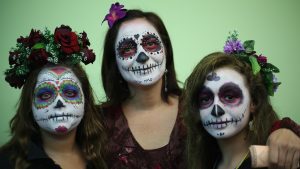The way we view death is often influenced by the society and culture in which we are brought up. Here in the UK, death remains quite a taboo subject in many communities, with fairly traditional customs surrounding it. We’ve talked about this taboo lots of times on our blog, as well as how to tackle it through various initiatives to get people talking and thinking about death. Not as something to fear, but as a natural part of life.
We’ve also talked about how funerals don’t have to follow the usual ‘format’ if you don’t want them to; that they can be personalised and include contemporary elements alongside the more traditional. Many of the traditions and customs that are still alive today date back to the Victorian era; a time when society followed strict ways as to how to mourn someone. They’ve shaped how many of us picture a traditional church funeral today: a somber affair; everyone dressed in black; a slow procession behind the hearse; and a wake following the burial or cremation.
In cultures where death is seen very much as a natural part of life, or a continuation into the afterlife, there tends to be a more celebratory feel. Does this perhaps make it easier to accept, and maybe even not so painful, for those left behind? Is the fact that we are so ‘shielded’ from death partly to blame for the taboo around it?
Take the Mexican Day of the Dead, or Día de los Muertos, as an example. Festivities take place over two days in a literal explosion of colour! It is a celebration of the life of deceased family members and a way to show their love and respect for them. All over the country there are parades and parties, costumes and face painting, as well as singing, dancing and offerings made to deceased loved ones.
Day of the Dead originated several thousand years ago, initiated by people who considered mourning the dead disrespectful. It showed that the dead were still part of the community, kept alive in memory and spirit and temporarily returning to Earth during the festival.

Here are some more stories from around the world that show how different cultures view death and how they approach funerals.
Indonesia
In Tana Toraja in eastern Indonesia, the deceased person’s body is kept in the family home. They are laid out in special rooms where they are seen as simply ‘asleep’. They are cared for and taken out, remaining part of family life, until the family has saved up enough money for a big, lavish funeral. These funerals will involve the whole community and are a real celebration of life, during which sacrificial water buffalo will carry the deceased’s soul to the afterlife.
Ghana
In Ghana, people often work on their own coffins, or have them made, before they pass away. They aspire to be buried in coffins that represent something special in their life – a hobby, their work or something symbolic to them. If you’re a fan of Karl Pilkington, you’ll remember him trying out a giant Twix as a coffin! There are also fish, cars, cameras – anything and everything!
Madagascar
Once every five or seven years, the Malagasy people go to their family ancestral crypt where the bodies of their loved ones lie wrapped in cloth. They exhume the bodies and spray them with wine or perfume. It’s a lively event with music and dancing, where they talk to the deceased, tell them their news or ask for their blessings. The ritual is called ‘famadihana’ or ‘the turning of the bones’ and keeps them connected to their loved ones.
Mongolia and Tibet
Many Vajrayana Buddhists in Mongolia and Tibet believe that the soul moves out of the body after death, leaving the body as an empty vessel that is no longer needed. The body is therefore placed on a mountaintop and exposed to the elements and wildlife, including vultures, so that it can be returned to Earth. This practice has been around for thousands of years and is still widely done.
Louisiana, USA
In New Orleans, Louisiana, you’ll find the jazz-tinged funeral procession. Mourners are led by a marching jazz band. The music starts quite sorrowful and slow and then moves upbeat after the body is buried and the celebration of life begins.
Customs and traditions aside, wherever you’re from and whatever your beliefs, you can create the funeral you want. Whether that’s to have your coffin ride alongside a Harley Davison or have everyone wear something yellow! Talking and being open about death and funerals makes it easier for everyone when the time comes.
Read the blog about personalising your funeral HERE

